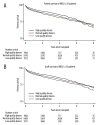Retrospective Analysis of the Impact of High- and Low-Quality Donor Livers for Patients with High-Acuity Illness
- PMID: 38192097
- PMCID: PMC10787593
- DOI: 10.12659/AOT.941931
Retrospective Analysis of the Impact of High- and Low-Quality Donor Livers for Patients with High-Acuity Illness
Abstract
BACKGROUND Patients with high-acuity liver failure have increased access to marginal and split liver options, owing to historically high waitlist mortality rates. While most research states that donor liver quality has no impact on patients with high-acuity illness, there have been inconsistencies in recent research on how liver quality impacts post-transplant outcomes for these patients. We aimed to quantify donor liver quality with various post-transplantation patient outcomes for patients with high-acuity illness. MATERIAL AND METHODS Using the liver donor risk index (LDRI), model for end stage liver disease (MELD), and clinically relevant recipient factors, we used multivariate logistic regression to analyze how donor liver quality affects varying measures of patient outcomes for 9923 high-acuity patients from June 18, 2013, to June 18, 2022. RESULTS Using LDRI, high-quality livers had a significant protective impact on high-acuity patient mortality, compared with low-quality livers (OR=0.695 [0.549, 0.879], P=0.002). High-quality livers also had significant impact on graft survival (OR=0.706 [0.558, 0.894], P=0.004). Two sensitivity patient mortality analyses, excluding patients with status 1A and hepatocellular carcinoma, showed significant protective findings for high-quality livers. High-quality livers had insignificant outcomes on long-term survivor mortality, length of hospitalization, and primary non-function outcomes, compared with low-quality donor livers. CONCLUSIONS While our findings suggest donor quality has an impact on high-acuity patient outcomes, these findings indicate further research is needed in intent-to-treat analysis on clinical offer data to provide a clearer finding of how donor quality affects patients with high-acuity illness.
Conflict of interest statement
Figures




Similar articles
-
The Utility of Extended Criteria Donor Livers in High Acuity Liver Transplant Recipients.Am Surg. 2021 Dec;87(10):1684-1689. doi: 10.1177/00031348211024658. Epub 2021 Jun 15. Am Surg. 2021. PMID: 34130521
-
Moderately Macrosteatotic Livers Have Acceptable Long-Term Outcomes but Higher Risk of Immediate Mortality.Transplant Proc. 2021 Jun;53(5):1682-1689. doi: 10.1016/j.transproceed.2021.03.024. Epub 2021 Apr 27. Transplant Proc. 2021. PMID: 33931249 Free PMC article.
-
Which recipient pretransplant factors, such as MELD, renal function, sarcopenia, and recent sepsis influence suitability for and outcome after living donor liver transplantation? A systematic review of the literature and expert panel recommendations.Clin Transplant. 2022 Oct;36(10):e14656. doi: 10.1111/ctr.14656. Clin Transplant. 2022. PMID: 35340054
-
[The effect of steatotic donor livers on the prognosis of donors and recipients after pediatric living donor liver transplantation].Zhonghua Wai Ke Za Zhi. 2022 Oct 1;60(10):922-929. doi: 10.3760/cma.j.cn112139-20220412-00159. Zhonghua Wai Ke Za Zhi. 2022. PMID: 36207981 Chinese.
-
Is living donor liver transplantation justified in high model for end-stage liver disease candidates (35+)?Curr Opin Organ Transplant. 2019 Oct;24(5):637-643. doi: 10.1097/MOT.0000000000000689. Curr Opin Organ Transplant. 2019. PMID: 31408016 Review.
References
-
- Feng S, Goodrich NP, Bragg-Gresham JL, et al. Characteristics associated with liver graft failure: the concept of a donor risk index. Am J Transplant. 2006;6(4):783–90. Erratum in: Am J Transplant. 2018;18(12):3085. - PubMed
-
- Rana A, Gruessner A, Agopian VG, et al. Survival benefit of solid-organ transplant in the United States. JAMA Surg. 2015;150(3):252–59. - PubMed
MeSH terms
LinkOut - more resources
Full Text Sources
Medical

